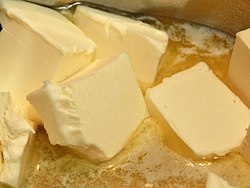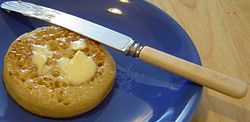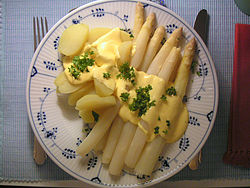Butter
Butter is a dairy food. It is made by moving the milk from whole cream for a long time.[1] The fat in the cream separates from the liquid. The fat is butter.
Butter is often put on bread, as a main ingredient in biscuits, as a shortening agent in some baking and cooking recipes, and for frying foods.
Often, butter is made from cows' milk, butter can also be made from the milk of other mammals, like sheep, goats, bison, and yaks.[2] Salt, flavorings and preservatives are sometimes added to butter.
Many people use butter in their foods instead of oil.
It has a melting point of about 45 °C (113 °F).
There are 717 calories in 100 g (3.5 oz) of butter.[3]
Types
Cultured butter is a butter made from fermented cream.[4] Sweet cream butter is butter made from pasteurized fresh cream.[5] Raw cream butter is butter made from fresh or cultured unpasteurized cream.
Butter Media
Liquid clarified butter
Traditional butter-making in Palestine. Ancient techniques were still practiced in the early 20th century. Source: National Geographic, March 1914.
Gustaf de Laval's centrifugal cream separator sped up the butter-making process.
Hollandaise sauce served over white asparagus and potatoes
References
- ↑ "Butter – How is it made? - Dairy Council Northern Ireland". www.dairycouncil.co.uk. Retrieved 2021-05-05.
- ↑ "Chemically How Does Milk Become Butter?". Office for Science and Society. Retrieved 2021-05-05.
- ↑ "Calories in 100 g of butter". www.nutritionix.com. Retrieved 2021-07-11.
- ↑ "What Is Cultured Butter?". www.vermontcreamery.com. Retrieved 2021-05-05.
- ↑ Tiffany (2016-06-23). "What Are The Different Kinds Of Butter (And How Do I Use Them)?". Food Republic. Retrieved 2021-05-05.
Other websites
 Media related to Butter at Wikimedia Commons
Media related to Butter at Wikimedia Commons










